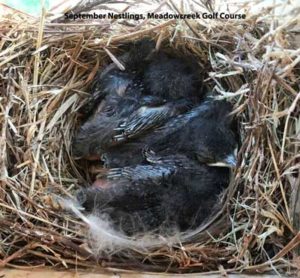
Eastern Bluebird September Nestlings
Meadow Creek Golf Course Trail
Contributed by Ann Dunn, County Coordinator for Albemarle and Fluvanna Counties, Virginia Bluebird Society
After several rather disappointing years, our native cavity nesters, and bluebirds in particular, experienced a very lively nesting season this past year. Thanks to the efforts of forty-five volunteers in Albemarle and Fluvanna counties, we received reports on 499 nest boxes from 42 trails. A total of 2,724 native cavity fledgings were recorded: 73 percent as Eastern Bluebirds, 19 percent as Tree Swallows, 4 percent as Carolina Chickadees and House Wrens, respectively, plus a couple as Tufted Titmice.
Comparison of nesting activity for the Albemarle/ Fluvanna trails in 2016 and 2017 shows that nest box usage (nesting attempts/box) increased from 1.45(2016) to 1.58 (2017). Both bluebirds and Tree Swallows contributed to this increase. Comparison of productivity (fledglings /box) in the same two years shows an increase from 4.78 to 5.46. The increase was due exclusively to bluebirds; Tree Swallows remained steady. Nesting survival (percent of eggs developing into fledging birds) differed significantly between the two species; with bluebird survival increasing from 76% to 82% in 2017, while that of Tree Swallows declined from 79% to 73% in the same period.
It’s hard to remember, but the winter of 2016-17 was remarkably warm. It likely resulted in a high survival rate for our local bluebird breeding population going into season. Thanks to a moderate early spring, the season began in timely fashion, with an average first bluebird egg date of April 5, somewhat before the Tree Swallows had even arrived from the south. Many individual reports indicated evidence of turf wars between bluebirds and swallows during the early nesting period. The productivity and nesting survival results suggest that the bluebirds were able to defend themselves quite well, given their head start to the nesting process.
An outstanding aspect of the breeding season this year was its length. After a very timely start, it didn’t shut down entirely until mid-September (an average of 136 breeding days). Thirty four boxes at 14 sites reportedly had triple nestings, usually all three as bluebird. In 2016 only one triple nesting was reported. The weather probably contributed to this extended season. The summer was relatively moderate, lacking prolonged periods of high heat, perhaps leaving our bluebirds with enough energy for one last nesting.
We are pleased with the results this year, but a bit concerned as we look out at the chill, hoping our local breeding population of bluebirds will survive the current cold spell. As always we look forward to spring and the next chapter in the breeding story.



